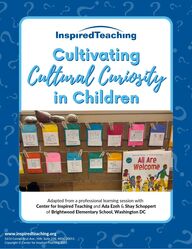
Return to flip book view
Cultural Cultural CuriosityCuriosityCultivatingCultivatingin in ChildrenChildrenwww.inspiredteaching.org 5614 Connecticut Ave., NW, Suite 258, WDC 20015Copyright © Center for Inspired Teaching 2025Adapted from a professional learning session with Center for Inspired Teaching and Ada Ezeh & Shay Schoppertof Brightwood Elementary School, Washington DC Message
www.inspiredteaching.orgCopyright © Center for Inspired Teaching 2025When we model comfort in who we are to the children in our lives, we createenvironments where children feel known and confident in the exploration ofdifference and diversity.This requires paying attention, being present, diving below the surface, allowingyoung people to speak more than we do, and creating the space, time, and roomto observe.During a recent Inspired Teaching professional learning workshop, Ada Ezeh andShay Schoppert, two PreK teachers from Brightwood Elementary, a school inWashington, DC with a diverse population of multilingual learners, offered fivesimple practices to promote cultural curiosity along with ten ways to helpchildren understand and appreciate diversity.2We use their imagination to create things so that they know theyare part of what is happening, and they are a part of theclassroom too…they’re telling us what they want to see happen.- Ada Ezeh, PreK Teacher
When adults demonstrate genuine curiosity andenthusiasm about each other's experiences,cultures, and perspectives, it sets the tone foryoung people to do the same. This creates aculture where joy and connection thrive!Encourage young children to practiceautonomy and independence.Giving children space to share the things theynotice not only provides us with information,but also enables them to take on the role ofexpert and lead explorations on their own. Youcan then use this information to furthercustomize opportunities for curiosity, allowingyoung people to actively participate in shapingtheir learning experience.Choose books or activities that havecommon, relatable experiences.We exist in a world full of diversebackgrounds and experiences; createmeaningful connections to that diversityby exploring what your children have incommon with others.Observe without interrupting.When young children workindependently, observe withoutinterrupting their play. This gives themthe opportunity to try a task on theirown, allows you to see where support orassistance is needed, and is another wayto get to know them.Just from observation, you can learnabout their preferences, what types ofplay or activities draw them in, andwhat guides their decisions about howthey navigate the room. Also, doingsomething hands-on can offer youngchildren a way to express themselveseven if they don’t yet have a lot oflanguage, or feel shy speaking up.Minimize chaos by keeping boundarieslimited, simple, and straightforward.Boundaries are essential to ensure everyone’ssafety and provide equal opportunities,whether when playing with new friends at thepark or navigating sibling relationships. Discussthem with each child and pose questions abouttheir importance.5 Simple Practices to Foster Cultural Curiositywww.inspiredteaching.orgCopyright © Center for Inspired Teaching 20253
1. Talk about skin and skin colors.4. Learn the names of people you see regularly in yourcommunity -- neighbors, mail carriers, supermarket cashier,etc. -- to build connections.5. Display artwork from or depicting an array of cultures.6. Include diverse representations in puzzles, coloringbooks, dolls, and imaginative play to reflect a varietyof identities.7. Read books that incorporate characterswith backgrounds different than your own.8. Order takeout -- or cook! -- cuisinefrom a culture you’ve never tried before.9. Seek out festivals or fairs celebrating diverse culturaltraditions or holidays in your community.10. Challenge perceptions.2. Create a book of “Who Do You See” based onobservations in your community, based on Brown Bear,Brown Bear, Who Do You See? by Bill Martin Jr.3. Provide creative materials that encourage exploring diversity.“I try to challenge whatever the perception is. Itry to go against the grain as much as possibleso they can see so many different ways oflooking at things.”- Shay Schoppert, PreK TeacherFor example, offer numerous shadesof paint to represent diverse skin,eye, or hair colors. 10 Ways to Help Children Understand & Appreciate Diversitywww.inspiredteaching.orgCopyright © Center for Inspired Teaching 20254There are lots ofdifferent skin colors;isn’t that beautiful?
www.inspiredteaching.orgCopyright © Center for Inspired Teaching 2025About Us5Center for Inspired Teaching is a social change nonprofitorganization that champions the power of curiosity and isdedicated to transforming the school experience fromcompliance-based to engagement-based. InspiredTeaching provides transformative, improvisation-basedprofessional learning for teachers that is 100% engaging –intellectually, emotionally, and physically.Please share this eBook -- and the Curisoity Challenge! -- to helpInspired Teaching make curiosity the word of the year in 2025.